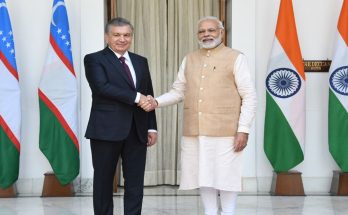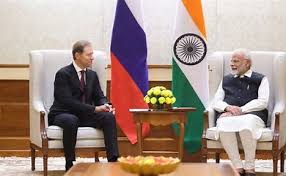 Billions of dollars in Foreign Direct Investment (FDI) have been assured to India thanks to Prime Minister Modi’s successful foreign tours and the visit of Chinese President Xi Jinping. Hopefully countries with more wealth and technology than us will help us create jobs. But in his efforts at gathering FDI, the Prime Minister is not any different from the previous government which also staged many road shows with union and state ministers, politicians and even the prime minister going abroad to woo foreign investors.
Billions of dollars in Foreign Direct Investment (FDI) have been assured to India thanks to Prime Minister Modi’s successful foreign tours and the visit of Chinese President Xi Jinping. Hopefully countries with more wealth and technology than us will help us create jobs. But in his efforts at gathering FDI, the Prime Minister is not any different from the previous government which also staged many road shows with union and state ministers, politicians and even the prime minister going abroad to woo foreign investors.
Everyone knows the advantages of FDI, but there are disadvantages also. One has to remember that FDI in the past has been capital intensive and not labour intensive. Foreign companies tend to use more technology to retain their competitiveness and flexibility than go for hiring more workers. Most are afraid of encountering labour problems. Millions of jobs, however, are needed in India and therefore there has to be a policy of encouraging labour intensive FDI. In mining industry, there is a danger of FDI harming the environment in their extractive manoeuvers. Hence India has to study carefully what kind of FDI it wants.
Choosing the right kind of investors is critical because India already has many consumer goods industries. What it needs is investment in infrastructure and capital goods industries. Yet most investors are reluctant to enter the infrastructure sector because returns are low and slow. If China can invest heavily in infrastructure in our neighboring countries, we should also insist on upgrading our infrastructure. Efforts have already begun in the building of industrial corridors like the Delhi Mumbai corridor with Japanese collaboration. But the problem in India is of delay and procrastination. If things could be done faster, India’s infrastructure would be efficient and competitive sooner.
 Since all countries are competing with each other for FDI, investors have the option of picking and choosing the country where they want to set up industries. More open economies with less government interference and good infrastructure are attractive to foreign investors. But more than anything, they prefer a disciplined and skilled labour force. That is a weak area in India (as compared to China) and has to be addressed through rapid skill development.
Since all countries are competing with each other for FDI, investors have the option of picking and choosing the country where they want to set up industries. More open economies with less government interference and good infrastructure are attractive to foreign investors. But more than anything, they prefer a disciplined and skilled labour force. That is a weak area in India (as compared to China) and has to be addressed through rapid skill development.
One can hope that the Modi government which is corporate friendly will make it easier for business to operate by lessening bureaucratic stranglehold and red tape. India ranks low ( 134th position) in World Bank’s ‘Ease of Doing Business’. It has to be seen whether these age old bureaucratic methods can be reformed easily. For example, both exporters and importers need to undertake a huge amount of paper work and get different types of clearances that spawn corruption and delays, all of which can cause patience to run out, making foreign investors pack up and go.
Actually, domestic investment is also facing the same obstacles as FDI. If the efficiency of the system improves, both would benefit. One can take note that China is now encouraging domestic investment and domestic consumption and is shifting away from export led growth. India has a lot of black money which could be used for domestic investment instead of being spent on gold and real estate and buying fancy cars.
 Widening the tax net could easily garner more financial resources for the government. Indians have billions of dollars stashed abroad in tax havens. What happened to the quest for bringing back black money from abroad? We would not require much help from foreign investors if money from Swiss banks could be returned to India.
Widening the tax net could easily garner more financial resources for the government. Indians have billions of dollars stashed abroad in tax havens. What happened to the quest for bringing back black money from abroad? We would not require much help from foreign investors if money from Swiss banks could be returned to India.
While on the one hand we are so eager to have FDI, on the other, we are letting our industrialists freely set up factories abroad. The outgoing FDI amounted to $29.34 billion in 2013-14. Why is Indian investment going abroad? Perhaps because Indian industrialists want highly skilled labour force and also the brand names of foreign companies through joint ventures, mergers and acquisition.
What then is the difference in the economic policies of the Modi government from the UPA? There seems to be little difference and the NDA government seems to be following the same path as the previous government in trying to please the western investors with promises of reforms. How rapidly the reforms are enacted could be the point of difference. So far, there has not been any significant reform but it is too early to say.
In Modi era, it is surprising that so much emphasis is being given on foreign investment and not domestic investment. It is slack domestic investment which is preventing manufacturing growth from picking up. This is linked to domestic interest rate policy which is bound by the rate of retail inflation which is refusing to come down to the desired level of 6 per cent.
Thus a lot of fine tuning will be needed to make the economy move forward and create jobs for the youth joining the labour force. Otherwise, there will be discontent and suffering. Also migrants who are coming to the cities daily, live in the most horrible conditions. They are without skills and assets. If this homeless population living on the streets is not settled by giving them work, then Modi’s promises will sound hollow. The street dwellers need to be looked after as citizens. Domestic investment will be able to give jobs to unskilled as opposed to FDI which will benefit those with degrees, experience and connections. Corporate salaries will see huge hikes and the problem of rising inequality of incomes will become worse.
Thus public investment in housing for the poor, healthcare and basic education will have to be stepped up that will give the ‘aam admi’ the ability to earn an income and live decently. Women’s participation in labour force has also to be increased. They should be employable in foreign enterprises and the conditions of work need to be good. Otherwise we are inviting disasters like the one in Bangladesh’s garment factory.
There also has to be real technology transfer that spills over to the local economy. Only then Modi’s dream of FDI as ‘First Development India’ can be fulfilled.
(The writer is a Senior Fellow at Observer Research Foundation, Delhi)
Author Profile
- India Writes Network (www.indiawrites.org) is an emerging think tank and a media-publishing company focused on international affairs & the India Story. Centre for Global India Insights is the research arm of India Writes Network. To subscribe to India and the World, write to editor@indiawrites.org. A venture of TGII Media Private Limited, a leading media, publishing and consultancy company, IWN has carved a niche for balanced and exhaustive reporting and analysis of international affairs. Eminent personalities, politicians, diplomats, authors, strategy gurus and news-makers have contributed to India Writes Network, as also “India and the World,” a magazine focused on global affairs.
Latest entries
 India and the WorldNovember 26, 2025G20@20: Africa’s Moment – The Once and Future World Order
India and the WorldNovember 26, 2025G20@20: Africa’s Moment – The Once and Future World Order DiplomacyOctober 4, 2025UNGA Resolution 2758 Must Not Be Distorted, One-China Principle Brooks No Challenge
DiplomacyOctober 4, 2025UNGA Resolution 2758 Must Not Be Distorted, One-China Principle Brooks No Challenge India and the WorldJuly 26, 2025MPs, diplomats laud Operation Sindoor, call for national unity to combat Pakistan-sponsored terror
India and the WorldJuly 26, 2025MPs, diplomats laud Operation Sindoor, call for national unity to combat Pakistan-sponsored terror India and the WorldJuly 25, 2025When Fire Ends, Diplomacy Begins
India and the WorldJuly 25, 2025When Fire Ends, Diplomacy Begins







